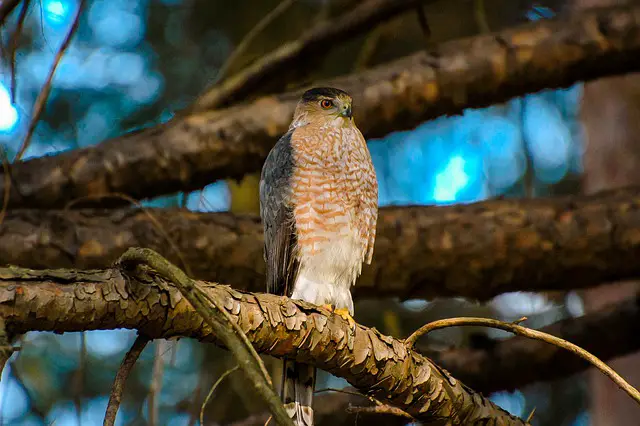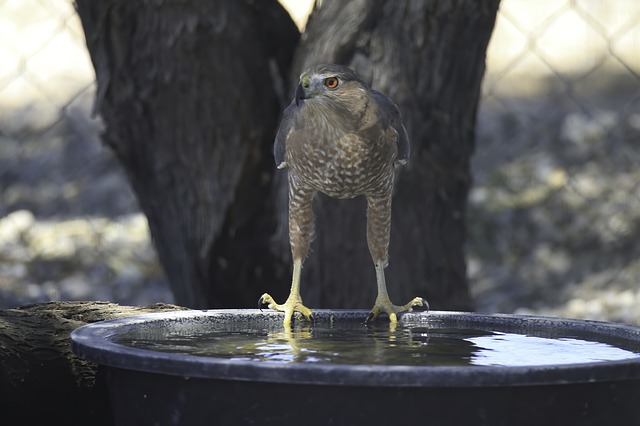In this article, we will explore the seven types of hawks found in West Virginia.
These include the Cooper’s Hawk, Red-tailed Hawk, Northern Goshawk, Broad-winged Hawk, Red-shouldered Hawk, Sharp-shinned Hawk, and Rough-legged Hawk.
I’ll provide an overview of each species, discussing their unique characteristics and habitats in the state.
| Image | Name |
|---|---|
 | Cooper's Hawks |
 | Red-tailed Hawk |
 | Northern Goshawk |
 | Sharp-shinned Hawk |
 | Red-shouldered Hawk |
 | Broad-winged Hawks |
 | Rough-legged hawk |
Types of Hawks in West Virginia
1. Cooper’s Hawk

Cooper’s Hawks are quite silvery blue hawks that are constructed for ripping through forested regions and treetops in order to take down their food.
It is a native of West Virginia throughout the year and is frequently confused with the Sharp-shinned Hawk, which is a tiny bird but has a coloration that is quite similar.
The male Cooper’s Hawk is much less large than its female counterpart.
The males are subordinate, and it’s only a coincidence that the female Cooper’s Hawks hunt and eat other birds that are around the same size as the males.
There is a distinct sound that the female makes that alerts the male that it is okay to contact her.
It takes the male bird around ninety days for the chicks to fledge, during which time the male is in charge of constructing the nest and providing food for the female and the nestlings.
Bird feeders in the garden may attract Cooper’s Hawks, who will feed from them.
The Cooper’s Hawk might swoop down on the area where the smaller songbirds are congregating in order to assist themselves to a feathery lunch.
They do not rely on this food supply as their primary source of nutrition, but if you take the feeder down for a few weeks, it will discourage them from visiting your backyard.
2. Red-tailed Hawk

The Red-tailed Hawk is an inhabitant of most of the US, especially West Virginia, and can be identified by its bright red tail and characteristic screech.
It gets its name from the color of its tail. These hawks are often seen in the area.
They would either wait for their prey by perching on telegraph poles or slowly circling over the meadows.
Even while studies imply that red-tailed hawks may live anywhere from ten to fifteen years in the wild, this might not be a completely true representation of their lifespan.
The oldest Red-tailed Hawk ever documented lived to be 31 years old.
In 1981, it was registered in the state of Michigan, and it was spotted in the state once again in 2011.
When they are courting, Red-tailed Hawks puts on a spectacular performance in the air.
It consists of swoops and steep dives, and every once in a while, the male and female may sometimes grab talons and look to drop to the earth, but they will back away from each other before really hitting the ground.
3. Northern Goshawk

A huge bird with a slate-gray appearance, the Northern Goshawk. Although it is uncommon across West Virginia, residents may, on occasion, get a glimpse of it during the winter months.
In the forest is where they both sleep and hunt, and they are quite excellent at keeping themselves concealed.
The name “Goshawk” originates from the Old English phrase “Goose Hawk,” which was a mention of the fact that perhaps the Goshawk often consumes the meat of other species of birds.
Because of its exceptional skill as a hunter, it was referred to as the “cooks hawk” back in the days when falconry used to be a prevalent kind of hunting.
The Goshawk will engage in combat with anything that comes too close to its nesting territory.
It is possible that this helps to explain, at least in part, why Attila the Hun adorned his helmet with a Northern Goshawk.
When goshawks are in their nests, they make a lot of noise, which should serve as a warning for people to keep away.
Goshawks, in contrast to Cooper’s Hawks, avoid living in or around human settlements.
It is quite unlikely that you will witness a goshawk at your feeder raising a commotion with the songbirds there.
4. Sharp-shinned Hawk

The Sharp-shinned Hawk and the Cooper’s Hawk are two raptors that are often confused with one another.
It is significantly smaller in size but has a color that is quite comparable to the other.
It lives in West Virginia throughout the whole year and chooses to make its home in the thick of the forest most of the time.
However, similar to its bigger relative, it has been seen reaping the benefits of a garden birdfeeder and the songbirds that it attracted in order to get a bite to eat.
In the beginning, the father, who is often much smaller than the mother, is the one who feeds the young together with the mother.
Before bringing his catch to his mate and their young, the male will first remove and consume the head of his prey.
When the chicks reach a certain age, the mother starts to feed them because she is now able to bring in bigger prey for them to consume.
In regions where Sharp-shinned Hawks have established themselves as permanent residents, the number of hawks that are seen throughout the autumn and winter months may rise.
During the winter months, sharp-shinned hawks across Canada make their way south.
The time of year when Sharp-shinned Hawks are most probably to be seen is during the fall migration.
5. Red-shouldered Hawk

The brilliantly colored Red-shouldered Hawk lives in West Virginia throughout the whole year, with the possible exception of the northern section of the state, which is the only place in the state where it goes during the breeding season.
These hawks like to live in forested places that are close to rivers and marshes, where they may make their nests out of sticks.
Great Horned Owls frequently prey on Red-shouldered Hawks by taking their young from the nest while they are still in the egg.
The hawks have previously been recorded working together, with one hawk pursuing the owl, whereas the other hawk devoured the owl’s young.
Both of the raptors have been seen performing this behavior.
The Red-shouldered Hawk has a total of five different subspecies.
The majority of these interact with one another in some way.
The hawk that is farthest to the west, on the other hand, is an outcast since it is separated from the others by one thousand miles.
There are subtle color differences between each subspecies that are caused by geographic location.
6. Broad-winged Hawk

During the breeding season, Broad-winged Hawk goes to higher elevations in West Virginia.
They spend the majority of their time roosting and hunting below the overhanging branches of the forest.
The shrill, single-pitched whistle that Broad-winged Hawks make may be used to identify them.
It is among the few times you will be able to view Broad-winged Hawks across the field.
They move south toward South America for such wintertime when they create exceptionally big flocks, which are highly coveted events for bird enthusiasts.
As a result of the enormous amount of Broad-winged Hawks traveling together, an effect occurs that certain people have referred to as “a river of raptors.”
This occurs because the hawks must compress themselves in order to go through places that are smaller.
7. Rough-legged Hawk

The winter months are spent across West Virginia by this hawk, which is unique among the hawks of North America in that its plumage extends all the way back down its legs.
They either perch and swoop down on their prey or hunt by turning their backs to the breeze and flying low in place while looking for food.
They would rather live in open places such as grasslands and deserts than in wooded regions.
When they aren’t reproducing, these hawks consume an incredible one-quarter pound of food every single day.
Once they reach the age of 17 days, hatchlings are capable of feeding themselves and are capable of eating a lemming in its whole.
During the forty days it takes for a pair of hatchlings to mature into fledglings, they will consume around 27 lbs of food.
In the wintertime, you could see them soaring or perched on a power pole. Either way, you can detect them.
Whether they are hovering or flying, Rough-legged Hawks may be recognized by the black spots that are seen on their abdomen.
In comparison to other birds who have a similar “hovering” habit, they possess a more robust build, which is another way to recognize them.
Conclusion
In conclusion, West Virginia’s diverse landscape is home to an impressive variety of hawks, each with its own unique features and behaviors.
The Sharp-shinned Hawk, Red-tailed Hawk, Cooper’s Hawk, Northern Goshawk, Broad-winged Hawk, Red-shouldered Hawk, and Rough-legged Hawk all contribute to the rich biodiversity of the Mountain State.
As you explore the beautiful outdoors of West Virginia, keep an eye out for these majestic birds of prey, and remember the important role they play in maintaining the delicate balance of the ecosystem.
By appreciating and conserving their habitats, we can ensure that future generations will also have the opportunity to witness these remarkable creatures in action.
FAQ
Where can I spot hawks in West Virginia?
Hawks can be found in various habitats across the state, including forests, open fields, wetlands, and suburban areas. You can increase your chances of spotting hawks by visiting state parks, wildlife refuges, and other natural areas during migration seasons.
What is the best time of year to observe hawks in West Virginia?
Hawk migration seasons, which typically occur in the spring (March-May) and fall (September-November), are the best times to observe hawks in West Virginia.
What do hawks in West Virginia eat?
The diet of hawks in West Virginia primarily consists of small mammals, birds, and reptiles. However, the specific prey items vary depending on the species and availability in their habitat.
Are all hawks in West Virginia year-round residents?
Some hawks, such as the Red-tailed Hawk and Red-shouldered Hawk, are year-round residents in West Virginia, while others, like the Broad-winged Hawk and Rough-legged Hawk, are migratory and only found in the state during specific seasons.
What is the largest hawk species found in West Virginia?
The Northern Goshawk is the largest hawk species found in West Virginia, with a wingspan that can reach up to 46 inches and a length of up to 27 inches.
How can I help protect hawks in West Virginia?
You can help protect hawks in West Virginia by supporting local conservation efforts, preserving their natural habitats, and reporting any illegal hunting activities to the authorities. Additionally, learning about and sharing knowledge of these magnificent birds can help raise awareness and foster an appreciation for their presence in the state.
Last Updated on March 22, 2023 by Lily Aldrin
